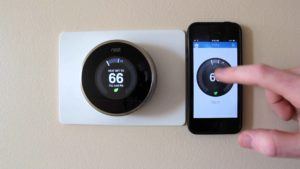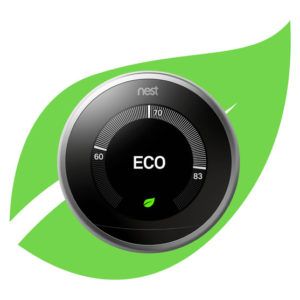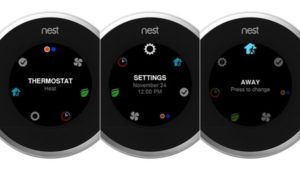Nest Learning About More Than Just Thermostats

Nest delivered an old idea of programmed temperature control in far more polished implementation. Can they continue to make the other elements of the home smarter and connected?
Nest created a modern version of the thermostat for personal homes. While it was not the first, Nest’s Learning Thermostat created consumer adoption through intuitive local controls, mobile access, and automation. This helped home cooling and heating save energy instead of just using energy. For example, Nest users can set an away mode or activate heat just before waking up. And Nest can adjust the temperature automatically based on weather conditions. Consumers and Nest share the burden as operators for Nests business model, so Nest’s role is eliminating consumer friction that has prevented adoption and continue automating decisions through learning.
Thermostats were invented in 1885, and in 1953 the iconic Honeywell “Round” was released. Programmability was added in the 1960’s but adoption has been slow and “programmable thermostats have largely fallen short” in terms of energy savings [6]. For U.S. households 97% had heating and 75% had cooling by 2005 controlled by thermostats. By 2008, heating and cooling comprised 42 of home energy consumption. Air conditioning is also the largest contributor to usage spikes after evening commutes.
Enter the Internet of Things
For decades, home appliances and other technology have only made incremental improvements in physical capabilities with minimal growth in smart components. Some even believe the quality of home appliances declined. Digital control panels, better sensors in stoves, emergency shutoffs in furnaces, and motion activated lights are a few examples of added smart components. But major innovations were few and far between. Modern kitchens might have appliances covered in new materials, but the overall function is still much like it was in the 1950’s. With the rise of ubiquitous and reliable home wireless networks and decreasing radio costs, connected devices from several companies are finally available for the home.
Nest’s Business Model
Nest’s primary business model improves the heating and cooling experience for consumers and reducing costs. To deliver on this promise, Nest provides users with an enhanced experience for setting the temperature in their home through automated decision making and mobile control in addition to the traditional method of local temperature control. Some of the elements had been available on programmable thermostats for decades, but Nest’s slick interface, machine learning, and transparency turned the idea into real savings. Nest’s users are a key piece of their operating model, and this is where past competitors failed to deliver. At the $250 price point, $131 average energy savings pays back in less than two-years plus additional subsidies in many areas.
This is just the beginning though. Nest, acquired by Google in 2014, aims to be the center device in a fully connected home, acting as the Trojan Horse. Local enhancements such as connections to smart blinds and macroscale tuning of temperature to smooth power demand are going to continue to change the operating model for the home’s largest energy consumption task. Backwards compatibility with existing HVAC systems was also key, but too much openness going forward will make it easier for competitors to steal other parts of the future connected home. Other big players such as Honeywell, Amazon, or Apple and several small companies are all fighting to be at the center.
The acquisition was also not without challenges. There has been infighting reported and other products have either failed to launch or have not been well received. The Nest Protect smoke detector was initially shunned by the market when several questioned its effectiveness on the core capability of detecting smoke. Before digitizing home devices, Nest needs to ensure the performance meets or beats incumbents. Nest could capitalize on its team’s ability to deliver better implementations of smart components, but needs move quickly in such a crowded space. They need to resolve these organizational dynamics in order to deliver more successful smart devices to homes that capture the value created by connectivity and mobility.
Push for Automation
In addition to eliminating friction when the user is needed for input, Nest should also continue automating the decision making for its users to improve the value captured by its devices. Their learning thermostat does this by remembering past usage or adjusting based on weather forecasts. Future product development needs to find these opportunities as well. For example, its smoke detectors could automatically notify neighbors or the fire department in the event of a fire. Ultimately users will only invest in these new technologies if they are better than incumbents and actually deliver the new value created.
[Word Count=715]
Sources:
- “Works with Nest” http://www.digitaltrends.com/home/works-with-nest-added-abilities/
- “How Smart, Connected Products Are Transforming Competition” by Michael E. Porter and James E. Heppelmann (Assigned Reading) https://services.hbsp.harvard.edu/services/proxy/content/56157960/56157992/2a598ecac93482e25ffab8d197783259
- “Vintage Stoves are better” http://www.slate.com/articles/life/food/2009/08/this_old_stove.html
- “Brief History of Thermostats” https://www.thermostat-recycle.org/blog/a_brief_history_of_thermostats_the_inventors/
- “Honeywell – Our History” http://www.honeywell.com/who-we-are/our-history
- “How people use thermostats in homes: A Review” http://eec.ucdavis.edu/files/How_people_use_thermostats_in_homes.pdf
- 7.” Google closes $3.2 billion purchase of Nest” https://www.cnet.com/news/google-closes-3-2-billion-purchase-of-nest/







Great post on a very relevant B2C IoT example!
While Nest has had a lot of buzz over the past couple of years, it seems like the consumer sentiment for “smart home” technologies is dwindling due to their unreliability. For example, Nest shut down its support of Revolv (a Nest acquisition in 2014) and therefore, rendered all purchased products obsolete for consumers. Given that most of the IoT products for a home rely on cloud-based software, if a company stops investing in or shuts down the cloud service, the customer value proposition disappears.
Reference: https://www.wired.com/2016/04/nests-hub-shutdown-proves-youre-crazy-buy-internet-things/
To increase adoption and quell customers’ fears, do you think Nest should enable their products to work outside of their cloud-based software (i.e. over wifi or bluetooth)? Or, do you worry that undermines their operating model / revenue streams?
Do you think Nest should revive its customer value proposition to reignite excitement and mitigate consumers concern’s for the practicality of IoT devices controlling the “smart home”?
I think that risk exists for any new technologies, but is exacerbated with the most recent ones that depend on ongoing services. Buried deep inside 20 page agreements that consumers don’t read is the legal non commitment for these services. Apparently, even John Deere’s model from another post only include right of use of their machine on purchase and not ownership of the whole machine. There’s just the increased possibility for the going concern of these new ventures. I think this an underlying element that explains the adoption curve; early adopters are willing to take on this risk.
I am always a fan of more openness, but I realize that doesn’t usually align with a company’s incentives to innovate. To be clear the device does communicate over wifi, but is only controllable through Nest’s closed proprietary app. More openness would be allowing other companies to connect and control a user’s nest thermostat. For example, Amazon is working to make these connections so users can use Alexa-enabled devices to change the temperature among other actions.
Jon, thanks for sharing. I think your article was spot on in capturing the potential of Nest to lead the way in terms of home automation.
There is a lot of overlap between your article and the one that I wrote concerning Smart Meters. I think that Nest is an important piece of the puzzle in pushing the Smart Grid forward, primarily by allowing consumers and utilities to cooperate through Demand Response. If Nest is given real-time rates from the utility (via communication through a Smart Meter), customers can pre-program their preferences for HVAC-electricity consumption based on price which 1) gives the customer more control over their consumption while 2) giving the utility an additional “degree of freedom” in meeting customer demand during peaks.
Ideally, this same concept would be applied to all residential electricity through the use of “Smart” products. However, I was surprised to see that heating and cooling already represent a full 42% of home electricity consumption! This makes the case for pairing of Nest with Smart Meters even more pressing. Do you have any thoughts on how the value of Nest changes with different rates of adoption of Smart Grid technology?
I wasn’t even aware they were doing the grid smoothing until researching for this post. While I think its a big opportunity, there is still a lot of overlap of when users want the cooling. And cooling earlier might require more energy overall or you’d need to exceed the temperature setting to use less during peak hours. Not sure if consumers would be ok overshooting by a few degrees to enable that.
Thanks for the interesting post, Jon! Not only is Nest a product (i.e., remotely controlled and machine learning thermostat), but it is now becoming a platform. As Emily mentioned, Nest is becoming a hub for other products in the IoT under its “Works with Nest” initiative. Products ranging from appliances to robotic vacuums and from app-controlled garage doors to Mercedes vehicles are all capable of connecting to the Nest platform. (Reference: https://nest.com/works-with-nest/). As Nest becomes know more as a platform than simply a thermostat manufacturer, the company’s business model will surely change to reflect the new value that its creating for and capturing from customers. One salient example was Nest’s acquisition of Dropcam in 2014. Similar to the effect of the Google acquisition, the Nest / Dropcam acquisition resulted in infighting and ultimate departure of Dropcam’s CEO months after the acquisition. One consequence of this internal strife was Nest had to backtrack on products previously announced or recently launched that the Nest management chose not to support, similar to the Revolv acquisition that Emily mentioned. This case study presents a great example of how acquisitions across technology companies can not only result in fundamental changes to a company’s business model, but, arguably more important, fundamental organizational changes through the merger of two cultures which leaders dealing with the impacts of technology and digitization must also consider.
Thanks for a great post Jon! I completely agree with you that Nest should focus on providing superior core performance versus competitors in order to better differentiate and come out ahead in this increasingly crowded IoT @ home space. I think your idea of automatically alerting neighbors of a fire is a great one, but maybe that could be an optional setting. There’s a lot that Nest and its machine learning capabilities can detect and suggest, but I would be cautious around decision-making just because false positives can be costly as well.